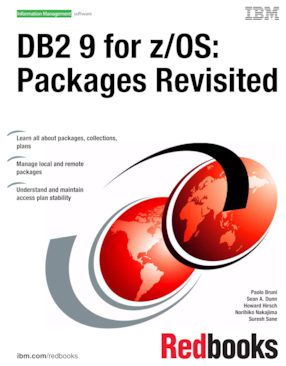DB2 9 for z/OS: Packages Revisited
An IBM Redbooks publication
Note: This is publication is now archived. For reference only.

Published on 02 March 2009, updated 07 September 2022
ISBN-10: 0738432369
ISBN-13: 9780738432366
IBM Form #: SG24-7688-00
Authors: Paolo Bruni, Sean A. Dunn, Howard Hirsch, Norihiko Nakajima and Suresh Sane
DB2® packages were introduced with DB2 V2.3 in 1993. During the 15 years that have elapsed, a lot has changed. In particular, there is a more widespread use of distributed computing, Java™ language, new tools, and upgrades in the platform software and hardware. The best practices back then just might not be optimal today. In this IBM® Redbooks® publication, we take a fresh look at bringing packages into the 21st century.
We begin with an overview of packages and explain the advantages of using packages.
Because database request module (DBRM) based plans have been deprecated in DB2 9, you need to convert to packages if you did not use packages already. We provide guidance on using a DB2 provided function to convert from DBRM-based plans to packages.
We re-examine the application development frameworks for packages: program preparation, package setup, and execution. For distributed applications, we include a discussion of a utility to identify and remove deprecated private protocol and converting to DRDA® as well as an introduction to the new pureQuery function of Data Studio. We also discuss common problems and their resolutions.
We then explore administration and operational activities dealing with packages, including security, access path management (where we discuss the newly introduced package stability feature to allow for a seamless fallback), and management and performance aspects.
The appendixes include useful queries and mention tools for managing packages effectively.
Part 1. Introduction to packages
Chapter 1. Overview of packages
Chapter 2. BIND options
Chapter 3. Execution flow of packages
Chapter 4. Conversion to packages
Part 2. Using packages
Chapter 5. Application development framework
Chapter 6. Developing distributed applications
Chapter 7. Common problems and resolutions
Part 3. Managing packages
Chapter 8. Administration of packages
Chapter 9. Security considerations
Chapter 10. Access path management
Chapter 11. Performance considerations
Appendix A. Catalog tables and EXPLAIN tables
Appendix B. Useful queries
Appendix C. DSNZPARMs, trigger packages, and tools
Appendix D. Sample test environment